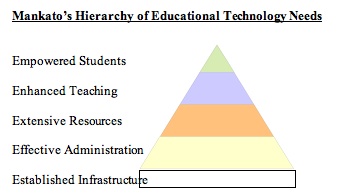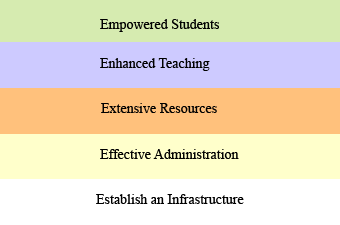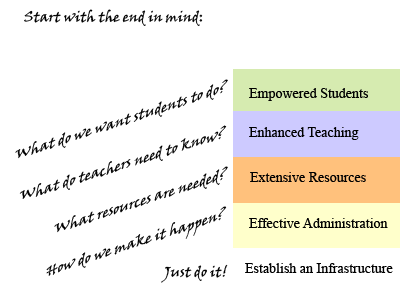
Tech Plan Part 4 – Implementation
When you get right down to it all the technology in the world and the best support structure are nothing if you do not take the time to implement the technology in a way that supports the structure of the entire plan. The process of implementing your tech plan can have lasting consequences on the buy in you get from stake holders. Implement the plan correctly and you bring the stake holders and the system along at the same time. Implemented incorrectly you can end up alienating stake holders or never fulfilling your tech plan’s goals.
Most schools do not have the financial freedom to implement a complete technology plan in the span of one year. Therefore, schools are forces to implement new technologies, new plans, over several years. Let’s face it, in the end it has to do with money. You need money to implement the tech plan. From switches and wires, to teacher training and support, it all costs money. Because schools are forced into multi year plans it is easy to get stuck in a routine of working on or focusing on one part of the plan without ever moving on. Infrastructure is usually where this happens. Schools decide they are going to focus on upgrading their infrastructure over a period of time. By the time they get done upgrading it is time to replace the 3 to 5 year old equipment to meet new standards. In these cases schools continually work on their infrastructure and never truly implement the technology into the school or classroom.
There are two things I believe can be done when creating a tech plan and implementing that tech plan. First, you must identify what it is you want end users to be able to do on a year to year basis. From there work backwards and create your infrastructure needs based on what you want teachers and students to do that year. Do not overbuild your infrastructure but instead build it to meet your users needs. Secondly, evaluate your technology and implementation plan on a yearly basis. You might create a 3 or 5 year tech plan, but technology does not stand still or wait for anyone.
Start with the end in mind
Doug Johnson provides a nice visual of the different layers of technology needs in school. I like the fact that the diagram shows that it is the technology infrastructure that is the foundation on which to build. You can not add hardware and software that your infrastructure cannot support.
What I do not like about the diagram is that the use of a triangle depicts that the infrastructure must be wider than the student and teacher use at the top of the triangle. Although you do need a solid foundation I believe your base should be in-line with your use. In other words, there is no need to have a base that is state-of-the-art if your users are only word processing. Build your infrastructure to support only what you need. So if I rework this diagram is looks like this.
In this way the infrastructure, resources, support, and outcomes are all in-line and supported by each other. We do not add more then we need, instead we build the system just large enough to support what we need. Once we understand that we are only going to build what we need instead of what we might need we can then look at what we want students and teachers to do with technology and work backwards to make sure that systems are in place to support those outcomes. So over three years our plan looks like this:
Even though the layers of support must be horizontal, the implementation of the whole system must be vertical. By implementing in a vertical format each year sees added value to the end user. Allowing stake holders to buy into a system and ‘see’ results on a yearly basis.
If a school only focuses on infrastructure, in many cases the end user does not ‘see’ results. A new server means nothing to a teacher. But being able to work with new content or enter grades online does. By implementing the plan in a vertical way we make sure that the user sees results yearly. They see the impact the money and hard work is having on the education system as a whole.
In word form it might look like this:
Students will: be able to upload multimedia projects to the web and embed them into their e-folios
Teachers will: be able to support students in the creating of multimedia projects and learn how to embed projects into e-folios
Resources needed: Time to train teachers, Time to train students
Infrastructure: Internet connection, server to house files, A way for students to upload videos and embed them on e-folios
Starting with knowing what we want students to do we can work backwards to make sure we have in place the infrastructure we need to make this outcome happen.
To often we think horizontally when implementing technology. We cannot afford to try and think of everything we might need our infrastructure to support. Technology evolves to fast to try and guess what we will need. Instead, we need to start with what we want students to be able to do and build an infrastructure that will allow us to do that today with an eye on tomorrow.
By looking at technology implementation through a vertical lens schools also can decide how much they can afford to do any given year. Each school’s budgetary demands are different. Some schools might take smaller chunks of their plan then others based on the financial resources they have available. No matter what a school’s financial resources are, by implementing in a vertical format a school ensures that the students are impacted in some way. That the end users are seeing results with the money and not just servers and wires in a locked closed.
Each school must decide how to best implement their plan, but by taking a vertical approach you focus on impacting education and student learning. Again, keeping our focus on student learning from the design through the implementation stage is a key factor in successfully bring all stake holders on board with a 21st Century Technology Plan.
[tags]techplan[/tags]
Technorati Tags: techplan











[…] Plan Part 4 – Implementation Jeff Utecht placed an observative post today on Tech Plan Part 4 – ImplementationHere’s a quick […]
[…] here for full […]
Jeff, this is brilliant, I really like how you think about things, must be the thinking stick. Your explanations are just so clear and your diagrams support visual thinkers. Thanks for making this series, I am using it!
Cheryl
Oh, I forgot to say my favorite piece, the resources you are explicit about when mentioning a n outcome. Makes so much sense.
I’m presenting this morning, and had the triangle diagram all set, so this is great food for thought. I’ll ask teachers how they would define/give examples of “empowered students”.
Thanks!
How about “empowered teachers”? Can I get an amen?
Hi Jeff,
I am pleased and flattered that you were able to modify and extent my old model. I created this model about 10 years ago when I could find a lot written about student skills and even staff development in technology, but little about how a good infrastructure or administrative systems fits into the whole tech planning effort. To me it was neglected.
My only quibble with your changes here is that a single school tech infrastructure supports many outcomes, not just one. Chances are students practicing skills, good home/school communication, a robust data-mining system, and course management software are all legitimate “outcomes” served by a single network and tech department. (My model doesn’t show this very well either.) You might have to say “begin with the ends in mind”, not end.
Great stuff. Keep writing and thinking, Young Skywalker!
Doug
Doug,
Thanks for your feedback. This is exactly why I’m writing these as a blog post before creating a final document. Your feedback is spot on. Once again I was to narrow in my thinking. I love the “begin with the ends in mind” that also fits with the rest of the plan when I talk about technology reaching into everything we do in schools today. I’ll have to reword this a bit for the final paper. Thanks once again for your knowledge and input.
Thanks you master OB One 🙂
Hey Jeff,
Excellent post! So cool that Doug was able to respond. I couldn’t agree more with your statement that “we need to start with what we want students to be able to do and build an infrastructure that will allow us to do that today with an eye on tomorrow.” It’s funny that when I was in the classroom full-time, standards and benchmarks were the farthest thing from my mind. And now that I’m playing a role in helping teachers integrate technology, I see how important it is to articulate the 21st century skills that we expect students to graduate each grade with.
I wonder if we sketched a few scenarios of what we want students and teachers to be doing with technology that it would inform and guide our vertical progress through the multi-year plan.
Onward and upward thru the tech plan!
Very timely. I work at a community college. We’re implementing AQIP as an accreditation strategy. “Technology” was identified as Job 1, so we have a team looking at that. Step One is coming up with a plan of course. This series is very applicable. Thanks!
Jeff,
Dennis, Stephen and I are planning our board presentation around the question – How has, is and will IT improve student learning at ISB?
We came up with same implementation framework as you (great minds!) with one small tweak. Instead of “what do we want students to do” we had “what do we want students to learn”. A small semantic shift but key when asking students and teachers to think about questions like:
How do I find and use information
to construct meaning and solve problems?
How do I responsibly use information and communication to positively contribute to my world?
How do I effectively communicate?
J
Forgot to check the “notify follow-up comments by email” box 🙂
Jeff,
‘Starting with the end in mind’ makes sense on so many levels. Not sure about SAS’s process for Tech Budget approval, but here at ISKL I typically liase directly with the school board. I am required to prepare several budget scenarios, then explain the impact of going from scenario A (read most expensive) to scenario B to scenario C and in a bad year scenario D. Regardless of how Tech savvy the Board members are, they are only interested in ‘how does this cost saving affect my childs’s learning?’ An answer of ‘well we can’t increase bandwidth, we’ll keep the HS Computers for a 5th year, and no increase in network storage ‘ hardly generates a buzz around the board room…. ‘With scenario A students will have the network space and processing power to collaborate and work on a video project, and with the added bandwidth they can enter their movie in the internationally recognized …..”
From time to time it is good to get a reminder that the technology is not as important as its purpose.
Chad
I happened to find this posting today, Jeff. Since we are just beginning our Technology Plan process, I would be interested in reading your Parts 1-3. Part Four is very helpful, but we could really use a few guidelines on getting started. Are your earlier entries archived somewhere?
Thanks.
Barbara
news update Google Holding Chrome OS Event Thursday. Complete Overview And Launch Plans To Be Revealed: http://j.mp/2Us5 http://url4.eu/mS73
[…] Johnson referring to changes in a tech planning model he had created. These changes suggested by Jeff Utecht modify the plan slightly but in a way that enhances the original plan. When I read his post […]